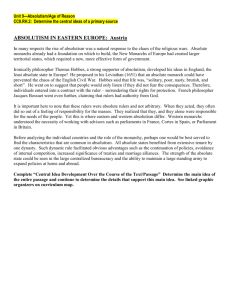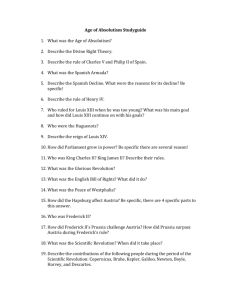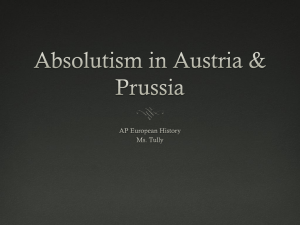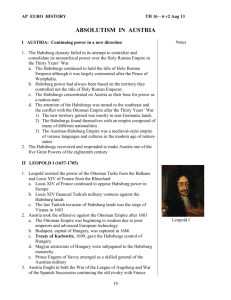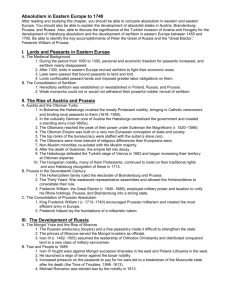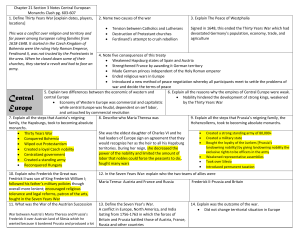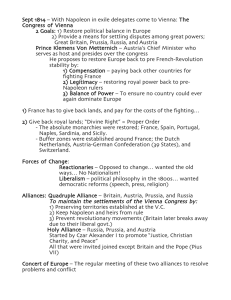Chapter 17-Lecture 2
advertisement
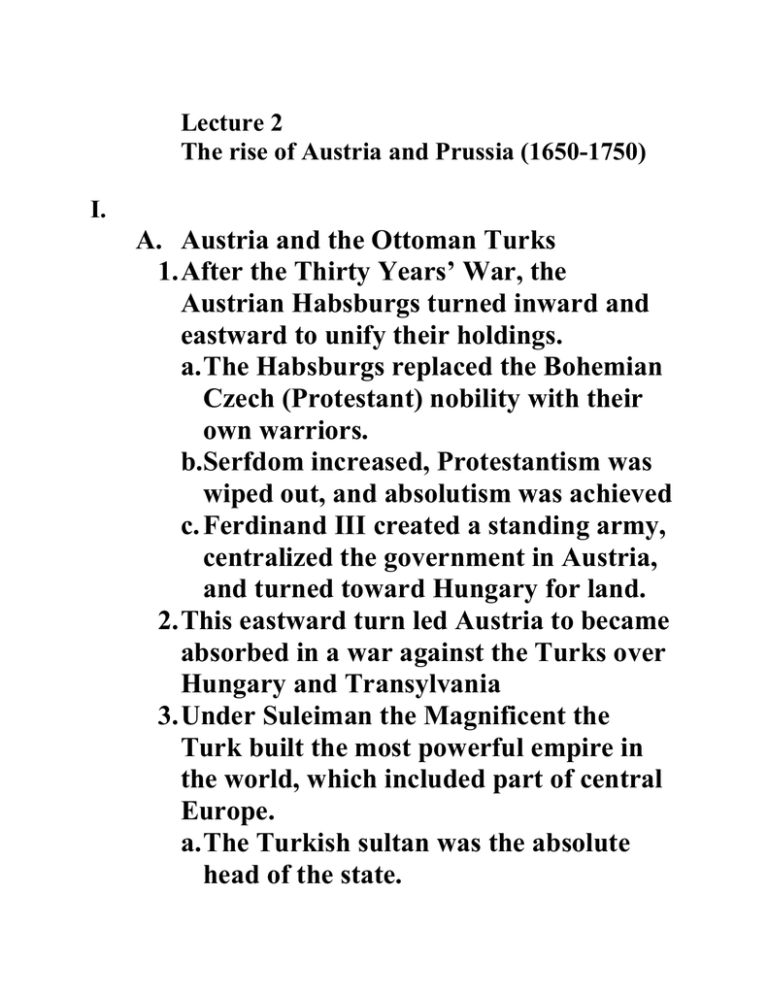
Lecture 2 The rise of Austria and Prussia (1650-1750) I. A. Austria and the Ottoman Turks 1. After the Thirty Years’ War, the Austrian Habsburgs turned inward and eastward to unify their holdings. a. The Habsburgs replaced the Bohemian Czech (Protestant) nobility with their own warriors. b.Serfdom increased, Protestantism was wiped out, and absolutism was achieved c. Ferdinand III created a standing army, centralized the government in Austria, and turned toward Hungary for land. 2. This eastward turn led Austria to became absorbed in a war against the Turks over Hungary and Transylvania 3. Under Suleiman the Magnificent the Turk built the most powerful empire in the world, which included part of central Europe. a. The Turkish sultan was the absolute head of the state. b.There was little private property, and a bureaucracy staffed by slaves. 4. The Turkish attack on Austria in 1683 was turned back, and the Habsburgs conquered all of Hungary and Transylvania by 1699. 5. The Habsburg possession consisted of Austria, Bohemia, and Hungary, which were joined in a fragile union a. The Pragmatic Sanction (1713) stated that the possessions should never be divided. b.The Hungarian nobility thwarted the full development of Habsburg absolutism, and Charles VI had to restore many of their traditional privileges after the rebellion led by Rakoczy in 1703. B. Prussia in the seventeenth century 1. The Hohenzollern family ruled the electorate of Brandenburg but hadlittle real power. 2. The Thirty Years’ War weakened the representative assemblies of the realm and allowed the Hohenzollerns to consolidated their absolute state. Frederick William (the Great Elector) used military force and taxation to unify his Rhine holdings, Prussia, and Brandenburg into a strong state II. C. Austria and the Ottoman Turks 6. After the Thirty Years’ War, the Austrian Habsburgs turned inward and eastward to unify their holdings. d.The Habsburgs replaced the Bohemian Czech (Protestant) nobility with their own warriors. e. Serfdom increased, Protestantism was wiped out, and absolutism was achieved f. Ferdinand III created a standing army, centralized the government in Austria, and turned toward Hungary for land. 7. This eastwa4rd turn led Austria to became absorbed in a war against the Turks over Hungary and Transylvania 8. Under Suleiman the Magnificent the Turk built the most powerful empire in the world, which included part of central Europe. c. The Turkish sultan was the absolute head of the state. d.There was little private property, and a bureaucracy staffed by slaves. 9. The Turkish attack on Austria in 1683 was turned back, and the Habsburgs conquered all of Hungary and Transylvania by 1699. 10. The Habsburg possession consisted of Austria, Bohemia, and Hungary, which were joined in a fragile union c. The Pragmatic Sanction (1713) stated that the possessions should never be divided. d.The Hungarian nobility thwarted the full development of Habsburg absolutism, and Charles VI had to restore many of their traditional privileges after the rebellion led by Rakoczy in 1703. D. Prussia in the seventeenth century 3. The Hohenzollern family ruled the electorate of Brandenburg but hadlittle real power. 4. The Thirty Years’ War weakened the representative assemblies of the realm and allowed the Hohenzollerns to consolidated their absolute state. Frederick William (the Great Elector) used military force and taxation to unify his Rhine holdings, Prussia, and Brandenburg into a strong state
